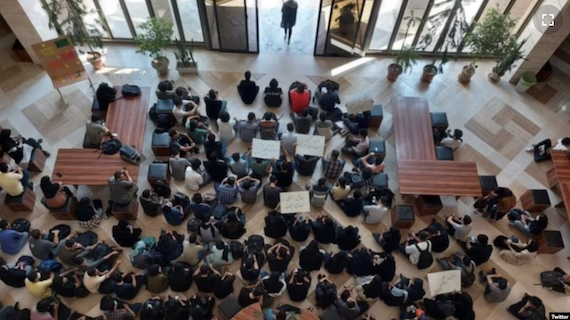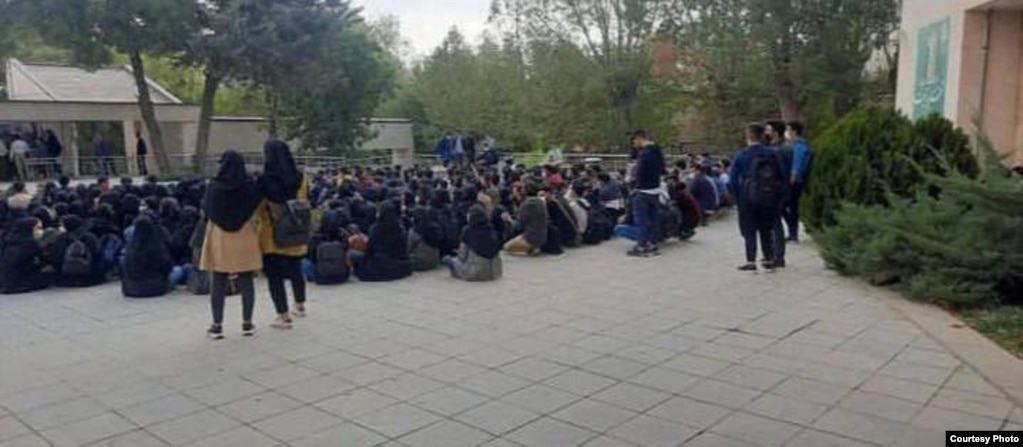( RFE/RL ) – Encouraging students to hold unauthorized demonstrations.
Encouraging students to sing antiestablishment slogans.
Encouraging female students to remove their head scarves.
Undermining Islamic values and acting against the interests of the system.
These are the list of reasons the Iranian authorities are using to increasingly purge the ranks of university professors in the wake of nationwide protests that rattled the clerical establishment.
That is according to a long-tenured university professor who was recently suspended. The academic, who spoke on condition of anonymity due to security concerns, came under intense scrutiny after students held demonstrations in solidarity with the nationwide protests.
The demonstrations broke out after the September 2022 death in custody of 22-year-old Mahsa Amini, who was detained for allegedly violating Iran’s hijab law on Islamic dress. The protests began as a rebuke against the brutal enforcement of the hijab, but soon snowballed into one of the most sustained demonstrations against Iran’s theocracy.
As the anniversary of the start of the protests approaches and a new academic year begins, the authorities have made clear that they will not tolerate a repeat of the type of student demonstrations that shook universities across Iran last year.
In recent days and weeks, officials have warned that students and educators will be under increased scrutiny, and there has been a wave of professors being removed from their positions.
Most appear to have been fired for allegedly supporting student protests related to Amini’s death and against the requirement that all women over the age of 9 wear the hijab, or hair-covering head scarf.
Students hold a sit-in protest at a university in Iran
On August 29, at least 10 professors were fired, some of them by way of a telephone call in what student unions have described as a “new innovation in suppressing and dismissing university professors.”
In the case of the professor who spoke this week to RFE/RL’s Radio Farda, the pressure is nothing new, though. “The events in my case are not recent and have been happening since the beginning of the protests,” the professor said. “I was the first member of the official faculty to make a statement in support of the students.”
After contesting the university’s legal right to invoke a suspension, the professor was brought before a disciplinary committee and informed that official complaints had been filed. More visits to various investigative committees followed.
The issue came to a head after student demonstrators at the campus were “brutally attacked” by university security personnel last year, according to the professor. That is when the professor was charged with five counts of “encouraging” the demonstrators, which the professor denied attending. Scores of students were also suspended by the university for participating in the protests, and the professor continued to support them.
“During this era of repression and intimidation, I stood by the students,” the professor said, adding that most “professors have no desire to involve themselves with the students’ issues.”
“This is the ugly story and sadness of Iran’s universities today,” the professor added. “Scientists, experts, and professors whose responsibility is to protect the independence of the university and preserve the dignity of the youth…why are they asleep?”
“Every day when I think about this fact, tears flow across my face and in my troubled heart,” the professor said. “It’s really unfortunate.”
‘They Fear The Universities’
Universities have historically been a battleground in the fight for social and political reforms in Iran.
During the Islamic Revolution of 1979, university students played a prominent role, including the occupation of the U.S. Embassy in Tehran. After the clerics came to power, the authorities instigated a mass purge of Iranian universities, firing hundreds of professors and altering curriculums to promote Islamic values.
Since the revolution, university students have voiced their opposition to the clerical establishment, including during a 1999 protest against the closure of a reformist newspaper, resulting in a raid on a dormitory at Tehran University that left one student dead.
The protests against Amini’s death on September 16 led to renewed pressure against students, specifically female students who failed to comply with the hijab law.
The targeting of professors and students by the authorities, however, is seen as a risk as Iran reels from an education crisis fueled in part by the exodus of academics to the West. More than 60 professors have reportedly been dismissed over the past two years.
In an interview with Radio Farda on August 30, one suspended educator said that while the authorities seek to Islamicize universities and purge them of educators who might pose a challenge to the clerical establishment, they are wary of going too far.
“The past 44 years have demonstrated that a part of the establishment, and I’m not saying all of them, but a segment, is afraid of universities, especially of social sciences,” said Dariush Rahmanian, an assistant history professor at Tehran University.
The Iranian Writers Association in a recent statement decried the moves against professors, warning that “the cycle of repression has become tighter and among the repressed are those who were the silent witnesses of previous repressions.”
“If society remains silent in the face of what is happening in universities today, it is feared that the tragedy of the university purges of the [past] will be repeated,” the statement added.
Michael Scollon contributed to this report.
Via RFE/RL
Copyright (c)2023 RFE/RL, Inc. Used with the permission of Radio Free Europe/Radio Liberty, 1201 Connecticut Ave NW, Ste 400, Washington DC 20036.




 © 2025 All Rights Reserved
© 2025 All Rights Reserved